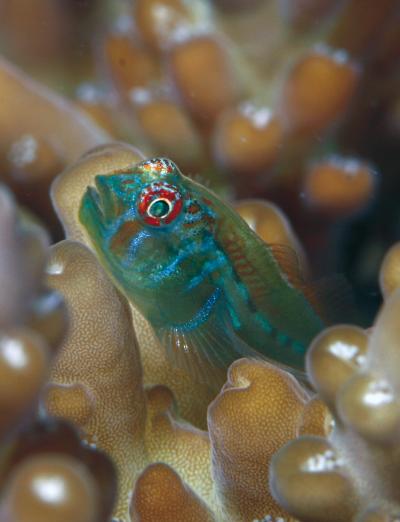
A juvenile Gobidon (goby) fish is shown on an Acropora coral. These fish spend their entire lives with the same coral, protecting it from encroaching seaweed. (Photo: Georgia Tech/Joao Paulo Krajewski)
Coral reefs provide one of the world’s most vital ecosystems and some of these reefs are in danger of being destroyed.
While people are to blame for much of the destruction, nature also plays a role. Encroaching species of seaweed with poisonous compounds on their surfaces are one of nature’s threats.
The toxic seaweed begins its lethal damage upon contact with the coral, killing its tissue within two to three days of contact.
But now scientists at the Georgia Institute of Technology have found that one species of coral near the Fiji Islands doesn’t sit around waiting to destroyed; it actually sends out a call for help when it’s threatened by poisonous seaweed.
Small fish, known as gobies, which are about two centimeters long and spend their entire lives in the crevices of the coral, respond to the coral’s alarm within minutes.
The gobies go after the seaweed, chewing and mowing it away from the coral. Not only do the little fish protect their homes, but some species also use the toxic substances from the seaweed to build up their own protective arsenal.
Mark Hay, a biology professor at Georgia Tech and colleague Danielle Dixson conducted the research and published their findings in Science.
Hay said two species of goby serve as coral bodyguards. One species simply chews away at the harmful seaweed and then spits it out, but the other type of fish actually ingests the poisonous substance. This enhances the fish’s already toxic characteristics, increasing its ability to protect itself from predators.

Coral protector Gobidon histrio (goby) in its living space on the coral Acropora nasuta. The coral is in contact with the toxic green alga Chlorodesmis fastigiata. (Photo: Georgia Tech/Danielle Dixson)
Researchers were unable to determine whether the fish were saving up the lethal seaweed compounds to use on enemies, or if they were already making their own poisons, and using the noxious material to build up their resistance to the poisons.
Not all fish possess the gobies’ protective instincts. Scientists also studied two other species of small fish that live in the coral.
According to Hay, these damsel fish simply swim away, moving on to other coral, when their homes are threatened.
“They just abandon it, say ‘It’s going to die, we’re out of here,’” Hay says.
Interestingly enough, the gobies are only protective when their particular species of coral is under attack. The scientists placed the gobies within another closely-related species of coral and found that the little bodyguards did not respond or protect their new home when it was under a similar threat.
Hay hopes to study other species of coral in the future to see if they too are also aided by rapid responding protective fish.
Mark Hay joins us this weekend on the radio edition of Science World. Tune in (see right column for scheduled times) or check out the interview below.
Audio clip: Adobe Flash Player (version 9 or above) is required to play this audio clip. Download the latest version here. You also need to have JavaScript enabled in your browser.

 Science World is VOA’s on-air and online magazine covering science, health, technology and the environment.
Science World is VOA’s on-air and online magazine covering science, health, technology and the environment.